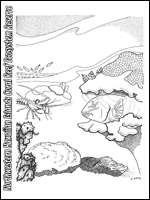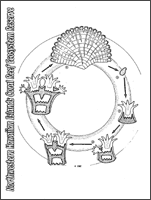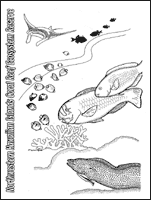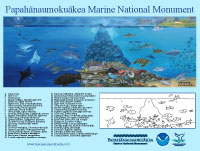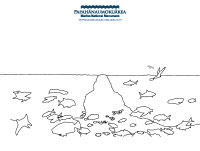
For Keiki (Kids)
Grab your crayons!Here are a few pages that you can print out and color. (coloring pages illustrated by Katherine Orr from a Pacific Reef Coloring Book. Text is also from that book).
Click on the images to get a larger version to print out.
Coral animals spread out their tentacles to feed, and brittle starfish come out of their hiding places. Spiny lobsters and octopi come out to hunt for food and the Uhu, or parrotfish, wedges itself into a crack in the rocks and blows itself a cocoon of mucus to sleep in. The mucus cocoon helps to hide the scent of the parrotfish from predators.
Fish that sleep during the day come out to feed at night. Small red cardinalfish
awake to eat plakton. The reef at night looks very different than during the day.
From time to time polyps produce eggs and sperm. These join to form a baby coral animal, called a planula (1), that drifts in the sea. If the planula finds a clean, hard surface, it attaches itself and turns into a polyp (2). The polyp grows and multiplies by budding (3). In this way, corals spread from one place to another.
Dead coral rock provides a hard surface where young coral can settle, but many other creatures settle there too. Often plants and sponges cover the surface before new polyps can attach. Or, plants may grow over young polyps and smother them. Reef animals such as sea urchins, parrotfish, snails, and limpets graze on the plants and sponges, making room for new corals to settle and grow. Most corals grow about one half inch or one centimeter per year, so it takes hundreds of years for a coral reef to develop (4). Without the help of animals that feed on fast-growing plants, a reef could never develop.
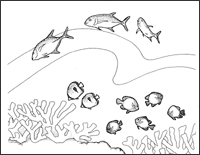 Pacific reef members: the swimmers
Pacific reef members: the swimmers
Coral reef fish vary widely in shape, color, size and behavior. Some travel long distances, while others stay within a limited reef area.
Blue jacks are strong swimmers. They do not shelter in the reef, but may visit to hunt small fish for food. Some butterflyfish, by contrast may spend their whole lives near a single clump of coral. A school of damselfish swims above the coral, feeding on plankton.
Two butterflyfish feed on a rock covered with limu (seaweed). Nearby, a moray eel pauses as a cleaner wrasse nibbles at the small parasites living among the teeth of the eel. The eel does not eat or chase the cleaner wrasse away. Instead the eel encourages the wrasse to remove pests by keeping its mouth open and remaining very still. In this way both fish benefit, the eel gets rid on parasites, and the wrasse gets a meal. This is called commensalism. Many creatures that live among the reef have developed different types of close relationships. In order to survive, one species must depend on the other.
The parrotfish makes scraping sounds as it bites chunks of dead coral, which are covered with a green film of plants called algae. The parrotfish digests algae and passes out coral skeleton as sand. It swims on as a school of milletseed butterflyfish glides past. Some butterlfyfish also feed on algae. Their grazing helps keep the fast-growing plants from covering the reef.
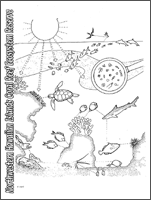
The coral reef is a living system
Every plant and animal on the reef has a special role to play. Some animals are active by day; others are active by night. Each has its own living space. Each has certain kinds of food, and in turn may also be a source of food for others. Some animals create homes for others to live in. Many have close relationships, each providing something the other needs.
The coral reef is a balanced system where all things have thier special place and function. In a system, all things are related. All the plants and animals of the reef depend on each other.
Our whole earth is a system too. Does this mean coral reefs are important to us, even if we don't live near one?
Word Hunt Puzzles (PDF)
Papahānaumokuākea Marine National Monument Mural
Click on the images to get a larger version to print out.
